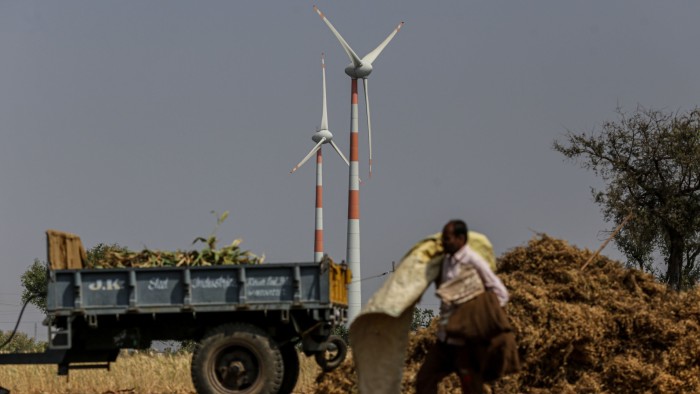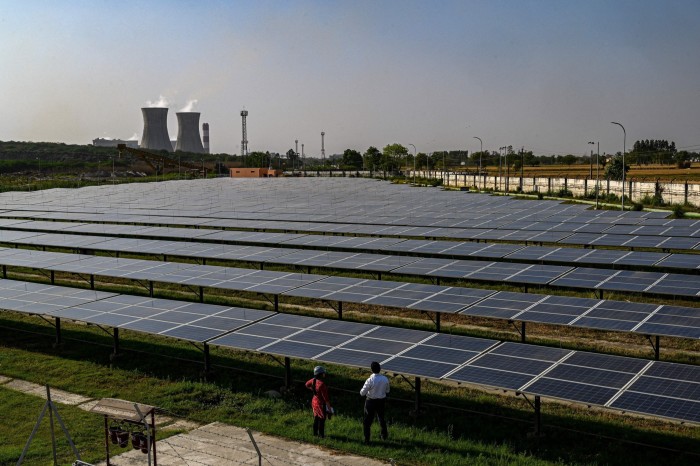India plots tricky path to growth and net zero

Simply sign up to the Climate change myFT Digest -- delivered directly to your inbox.
India comes to COP27 as part of an exclusive club: one of around twenty countries to have submitted updated plans for mitigating greenhouse gas emissions since the last global climate conference in Glasgow, last November.
Prime minister Narendra Modi then committed to having net zero carbon emissions by 2070, later than the 2050 deadline set by many other countries.
India and China were also at the centre of upset in Glasgow after they were accused of insisting that a UN commitment be only to “phase down”, rather than “phase out”, coal use.
Even so, the world’s third-largest polluter has now added to the commitments its government made in Glasgow.
In August, New Delhi provided more details on changes to its so-called Nationally Determined Contribution targets, updating its previous submission from 2015.

Firstly, India has committed to reducing the emissions intensity of its GDP by 45 per cent from its 2005 level — previously it had aimed for a cut of just 33-35 per cent by 2030.
Rajat Gupta, who leads consultancy McKinsey’s sustainability practice in Asia, describes this measure as “grammes of carbon for every dollar of GDP”, which helps weigh carbon emissions in relative, rather than absolute, terms because India’s economy is growing from a low industrial base.
Although India is ranked the third worst emitter of greenhouse gases in total, its environmental impact per head is far lower than that of counterparts calling for tougher collective action — because it is the world’s second most populous country.
A UN report published in October confirms India is behind China and the US in the ranking of total greenhouse gas emissions in 2020, ahead of the EU trading bloc (now excluding the UK) and the Russian Federation. But India’s per capita level of greenhouse gas emissions is well below half the world average, according to the report.
More stories from this report
‘Loss and damage’ debate set to dominate the COP27 agenda
US needs yet more ‘huge lift’ to hit Paris goals
Australia takes steps to catch up on climate action
European crisis risks climate action reputation
Pressure remains on Xi Jinping to kick China’s coal habit
Cairo sets agenda for ‘the African COP’ at Red Sea resort
Media have big responsibility in the age of global warming
Still, at 1.4bn people, the scale of the country’s population gives cause for concern over the future trajectory of its carbon consumption.
India is currently bringing down the emissions intensity of its economy, aided by a large services sector which is less polluting than heavy industry. According to an analysis by the New Delhi-based Centre for Science and Environment (CSE) in 2021, India’s emission intensity is down 24-25 per cent since 2005.
In its second updated plan to the UN, India has also pledged to get half of its installed electric power from “non-fossil fuel-based energy” — 10 percentage points more than its previous goal.
Given that India is reaching roughly 40 per cent non-fossil fuel installed electrical capacity already, “achieving 50 per cent by 2030 is definitely do-able,” says Avantika Goswami, climate change programme manager at CSE. However, some critics say this target is not sufficiently ambitious.

Beyond its climate targets, there are other reasons for India to boost renewable power generation: it needs a whole lot more electricity. “Frankly speaking, we have to do it,” says Sumant Sinha, chair and managing director of Indian renewable energy producer ReNew Power, “because we are going to have a lot of demand growth in the power sector.” Analysts point out that renewable power is now cheaper than burning fossil fuels.
India’s growing population and economy mean it must rapidly produce more electricity. It is still highly dependent on burning fuels like coal, which generate 58 per cent of its power, according to official statistics. Solar, by contrast, contributes 15 per cent, while hydro is 11.5 per cent.
Private investment is set to expand India’s renewable capacity, though. Many of the country’s biggest companies — from the Adani Group to Reliance Industries and Tata Group — are highly dependent on fossil fuels. Yet they have made ambitious investment commitments to green energy production including solar and green hydrogen.
As the world’s third-biggest oil importer, India also hopes that investing in renewables will give it greater energy independence.
But the cost of transitioning is extremely high for India, given it is already a low per capita greenhouse gas emitter and still suffers high poverty levels. In a report published in October, McKinsey estimated that the bill for green investments to decarbonise India could be as much as $12.1tn until 2050.
New Delhi expects developed nations — which historically have emitted most of the greenhouse gases — to help with money and technology. At COP27 in Egypt, Goswami expects India to push for “more financing for green technologies”, to achieve “decarbonisation across hard-to-abate sectors” in particular.
Gupta says that New Delhi is showing commitment to its emissions targets. For example, it is providing incentives for businesses that manufacture the components needed to build renewable energy capacity and developing policies to support electric vehicle adoption.
But he believes the government needs a clearer road map for decarbonisation: “If there is a steady hand on the policy front, industries or companies will invest the billions and the tens of billions that are needed for this transition to work.”
Comments